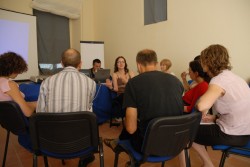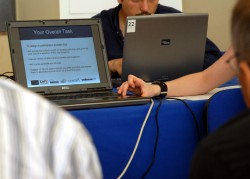To design a participative process for a consortium of UK science centres (based in Scotland and England) aimed at young people aged between 14-19 years old to feed into a national public consultation.
Contact:
- Susan Meikleham, Science Education Coordinator, Glasgow Science Centre, susan.meikleham@glasgowsciencecentre.org
- Julia Kingston, Education Manager, Thinktank, julia.kingston@thinktank.ac
Short description of the case
This case study is based on a project run by Escite uk in partnership with Thinktank Birmingham Science Museum, Glasgow Science Centre, Centre for Life, Newcastle and Museum of Science and Industry, Manchester which ran from 2005-2007.

It refers to the experience of the the Nuffield Council on Bioethics (NCoB) that were holding a consultation in order to gauge public opinion on the ethical, social and legal dilemmas raised by foetal and neonatal medicine.
Participants will address the objectives set by a consortium of UK science centres to create a participatory process using scientists that will engage and provide the views of school students aged between 14-19 years old for a public consultation to examine ethical issues raised by new developments in biology and medicine called ‘The ethics of prolonging the life of fetuses and the newborn’.
Training objectives
Participants will learn:
- To take into account the importance of issue framing when designing a participatory process for school children (14-19years old) in terms of linking to the statutory curriculum and the needs of the consulting body
- To take into account the need to engage a young audience when reframing questions
- Strategies for choosing a participative process that will engage young people who are unfamiliar with them
- To design a participatory process for young people (including choice of method, how to feed back results to consultation body, how to involve scientists and science centre staff in the process and methods of dissemination)
This case study is specifically of interest to those who are involved in science centres or museums. It will also interest those who are interested in consulting with young people on ethical issues relating to biology and medicine.
Training method
Participants will work in small facilitated groups to complete a series of tasks leading to discussion and design of a participatory method to involve young people. Results will be fed back to the whole group after the completion of some of the sessions. These results will inform further tasks.

Participants will need to consider the restrictions the actual project worked with for example: When working within a science centre and using their staff, how do you involve scientists? They will be asked to bear in mind a number of planning steps when framing the questions and choosing the final methodology being sensitive to the needs of the audience and the venues. They will need to give a rationale for their choice. The final stages of the session participants will be asked to consider methods of dissemination that could be used and how to achieve good media and PR coverage for the project.
This case study requires 5 hours with an 30 minute introduction to set the context and clarify any questions; approximately 4 hours on tasks and discussion in small groups; 30 minutes feed back.
Previous knowledge required
To gain the most from this case study a good knowledge of participatory methods and working with young people is an advantage.
- ID card Doing Dialogue
- Consultation report NCoB
http://www.nuffieldbioethics.org/fileLibrary/pdf/NCOB_prolong_life_consult_paper.pdf
Materials
Necessary
- A room large enough for all participants to accommodate dividing into smaller groups for discussion
- Flip charts/pens and stands -one for each group
- Pens and paper for participants to make notes
- POST IT notes
- Pack of ‘Blu Tac’
- Equipment to show a power point introduction
Guideline on how to work with the case study
1. Read: the ID card Doing Dialogue [36.9 kb, pdf]
A. INTRODUCTION
2. Read A1: the PPP Introduction of the programme and the purpose of the workshop [23.7 mb, ppt] and don’t forget to read the notes!
3. Read for more information on the partner organisations:
B. CASE DEFINITION
4. Read: B1a: the Scottish emerging curriculum [45.4 kb, pdf] and the document B1b: Understanding the National Curriculum [54.2 kb, pdf]
For more information on the Guidance on the English National Curriculum see: http://www.direct.gov.uk/en/EducationAndLearning/Schools/ExamsTestsAndTheCurriculum
or the guidance on the Scottish National Curriculum see: http://www.ltscotland.org.uk/5to14/curricularareas/science.asp
Divide – if necessary – in two groups.
5: Task 1: read B2 [59.9 kb, pdf] and choose amongst 7 questions the one that best suits to the demand.
Make use of B3: the consultation document of the Nuffield council on bioethics (NCoB) [279.4 kb, pdf] to answer this task.
6: Present case definitions in plenary.
C. DESIGN THE PARTICIPATIVE PROCESS

7: Plenary brainstorming session to write up on flip chart different participation methods.
8: Split into groups to way up the pros and cons of these methods using the prompt questions of C1: Draft the procedure [34.5 kb, pdf]
9: Check your ideas with C2 ‘A Review of Public Participation and Consultation Methods’ [75.7 kb, pdf] and the CIPAST methodology posters (see chapter 4.2 ).
10: Design a participative process that:
- Will provide the Nuffield council on bioethics with the views of 14-19 year olds on a selection of their key questions
- Can be carried out within science centres and museums
- Will involve scientists and ethicists
- Targets 14-19 year olds in schools (and their teachers) and enables them to attend the science centre for at least five hours
11: Choose one participative process in plenary.
D. IMPLEMENTATION OF THE PROCEDURE
Split in three groups.
12: The groups focus on different aspects of the implementation
- Group 1: read the question card D1 [35 kb, pdf] and define the role of marketing the media in the chosen process by answering the questions. Write a short press release to promote these events.
- Group 2: Justify why you choose the participatory method over other methods by using the record of the earlier discussion and answering the questions in D2 [34.2 kb, pdf].
- Group 3: answer the questions of D3 about the process [34.7 kb, pdf] and you will get an idea of the final programme.
All groups can make use of D4 ‘Stakeholder backgrounds’ [371.6 kb, pdf]
13: Summarise your results and deliver a 3 minute presentation in plenary at the end of the session
14: Read the outcome of the real case study in D5 ‘Doing Dialogue Support Material’ [31.9 kb, pdf] and D6 ‘Critical care decisions in fetal and neonatal medicine: ethical issues’ [88.7 kb, pdf], a summary of the NCoB report: Critical care decisions.
E. EVALUATION
15: Please fill in E1: the handout participants impressions [17.1 kb, pdf]: positive and negative about this case workshop
F. Schedule (based on Procida workshop):
| Start | End | Activity |
|---|---|---|
| 9:00 | 9.15 | Introductory PowerPoint |
| 9.15 | 9.30 | Questions and clarifications |
| 9:30 | Split into groups | |
| 9.40 | 10.20 | Consultation document – curriculum exercise (which results in the case definition) |
| 10.20 | 10.45 | Present case definitions and agree on one |
| 10.45 | 11.00 | Break |
| 11.00 | 11:40 | Choosing a participative process – task |
| 11.40 | 12.00 | Group discussion on processes and selection of one |
| 12.00 | 13.40 | Groups work on following tasks: |
| 13.40 | 14.00 | share results and evaluation |


